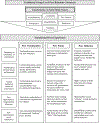Transformation of Adolescent Peer Relations in the Social Media Context: Part 2-Application to Peer Group Processes and Future Directions for Research
- PMID: 29627906
- PMCID: PMC6402323
- DOI: 10.1007/s10567-018-0262-9
Transformation of Adolescent Peer Relations in the Social Media Context: Part 2-Application to Peer Group Processes and Future Directions for Research
Abstract
As social media use becomes increasingly widespread among adolescents, research in this area has accumulated rapidly. Researchers have shown a growing interest in the impact of social media on adolescents' peer experiences, including the ways that the social media context shapes a variety of peer relations constructs. This paper represents Part 2 of a two-part theoretical review. In this review, we offer a new model for understanding the transformative role of social media in adolescents' peer experiences, with the goal of stimulating future empirical work that is grounded in theory. The transformation framework suggests that the features of the social media context transform adolescents' peer experiences by changing their frequency or immediacy, amplifying demands, altering their qualitative nature, and/or offering new opportunities for compensatory or novel behaviors. In the current paper, we consider the ways that social media may transform peer relations constructs that often occur at the group level. Our review focuses on three key constructs: peer victimization, peer status, and peer influence. We selectively review and highlight existing evidence for the transformation of these domains through social media. In addition, we discuss methodological considerations and key conceptual principles for future work. The current framework offers a new theoretical perspective through which peer relations researchers may consider adolescent social media use.
Keywords: Adolescents; Cyber victimization; Peer influence; Peer status; Review; Social media.
Conflict of interest statement
Figures
References
-
- Almquist YB, & Östberg V (2013). Social relationships and subsequent health-related behaviours: Linkages between adolescent peer status and levels of adult smoking in a Stockholm cohort: Peer status in school and adult smoking. Addiction, 108(3), 629–637. 10.1111/j.1360-0443.2012.04097.x. - DOI - PubMed
-
- Baker CK, & Carreño PK (2016). Understanding the role of technology in adolescent dating and dating violence. Journal of Child and Family Studies, 25(1), 308–320. 10.1007/s10826-015-0196-5. - DOI
Publication types
MeSH terms
Grants and funding
LinkOut - more resources
Full Text Sources
Other Literature Sources
Medical
Research Materials


